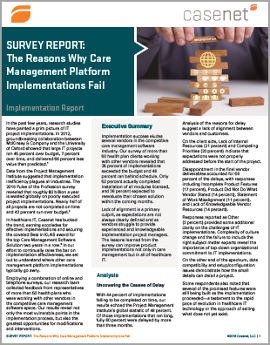In the past few years, research studies have painted a grim picture of IT project implementations. In 2012, a groundbreaking collaboration between McKinsey & Company and the University of Oxford [1] showed that large IT projects ran 45 percent over budget, 7 percent over time, and delivered 56 percent less value than predicted.
Data from the Project Management Institute suggested that implementation inefficiency plagues all industries. The 2018 Pulse of the Profession survey [2] revealed that roughly $2 billion a year is wasted globally on poorly executed project implementations. Nearly half of all projects are not completed on time and 43 percent run over budget.
In healthcare IT, Casenet has bucked the trend, earning accolades for effective implementations and securing the coveted Best in KLAS award [3] for the top Care Management Software Solution two years in a row. In our effort to continually raise the bar on implementation through-put, we launched the Casenet Implementation Survey to understand where other care management platform implementations typically go awry.
What we discovered: There is a lack of alignment between vendors and clients during the implementation process which led to a high degree of dissatisfaction and eventual product turnover. Thirty-six percent of our respondents indicated that they were looking to reevaluate their care management solutions. Of those, 62 percent were committed to finding an alternative within the next six months.
Given the disruption involved in replacing a software solution, how might the implementation process be improved to deliver a more productive result? Based on the data, we draw the following lessons, which may be extended to improve implementation outcomes across all of healthcare IT.
1. Software technology may suffer from a degree of “over-promising.”
A small but consistent theme throughout the Casenet implementation survey was the complaint that clients didn’t receive all the features they expected or that they licensed. Of those who never fully installed the software, 12 percent indicated that it was because the product did not have all the capabilities they purchased. This is underscored by the respondents who noted project delays due to the fact that features were still being developed during the implementation process.
Clients may avoid this outcome by doing a few activities prior to engaging with a vendors:
- Working with their procurement team to evaluate and prioritize the organization’s strategic drivers, opportunities they seek to capitalize on, and operational pain points they need to ameliorate. These findings will serve as a benchmark for evaluating the features that target products should possess today, and how the product roadmap should align to the client’s organizational direction in theme and timeline.
- Prioritizing requirements based on anticipated benefit to the organization and based on the resource pool’s capacity to undertake new projects within specific time horizons.
- Looking beyond just product demos when selecting a vendor, and utilizing current client references and third-party assessments to substantiate the evaluation and determine if the vendor can offer an honest, ongoing partnership.
2. Implementation teams must be visible during the sales process.
Vendors who don’t align their sales and implementation teams can expect disappointment at go-live. Twenty-three percent of respondents in the survey reported that the implementation statement of work created during the sales process did not align with their business needs at go-live, and an alarming 26 percent believed that the implementation team did not understand their company’s future business goals.
Close collaboration is required to ensure that Statements of Work accurately reflect the clients’ business goals, that product features are delivered as promised, and that all the necessary technical support will be put into place.
During the sales process, clients should insist upon meeting their designated implementation teams to ensure not only that goals are clearly outlined and understood, but also that the team is prepared to guide the process. Transparency into the entire vendor organization will aid clients in ultimately selecting the right vendor partners.
Understanding that clients are ultimately paying for predictability, we established a framework predicated on involving the implementation team prior to the start of the project to collaborate with the sales team during the contracting phase. This framework involves ascribing the implementation team ownership for SOW generation; the success of which is centered on a system-agnostic discovery process aimed at aligning the aforementioned clients strategic and operational objectives to existing product features, and establishing an engagement model that works best for the client’s operational style. Early collaboration between client and vendor implementation teams has helped establish appropriate success measures, and consequently a stable foundation for budget and timeline predictability.
3. Implementation teams may be weak links for some vendors.
The 26 percent of clients who believed that their implementation teams did not understand their future business goals all expressed disappointment in the teams’ level of expertise. Some noted specifically that their implementations seemed to be managed by a subsegment of the organization. Others pointed to a peculiarly high turnover rate of team members throughout the implementation process.
Software solutions may be particularly susceptible to this challenge as companies find themselves inadvertently prioritizing their development teams in order to keep up with the demands of rapidly changing technology. However, the strongest vendor partners are those that understand the critical role implementations play in the long-term success of both companies. The implementation teams must be staffed by talented project managers who receive ongoing support and training from the entire vendor organization.
Given the configurable nature of our product at Casenet, a knowledge transfer based implementation approach is utilized to establish shared accountability for project deliverables between Casenet and client. During the delivery phase, work iterations are equally focused on delivering demonstrable features as on increasing client self-sufficiency throughout the project. This approach, accompanied by the appropriate project reporting diligence, has provided appropriate visibility and better coordinate any potential staffing adjustments.
Additionally, with software products continuing to their feature set to keep up with the rapidly evolving industry desires, no implementation team can be expected to stay abreast of all product features to the level of detail needed to address the various permutations of client scenarios. As such, our methodology incorporates the mechanisms needed to request necessary support from product management and development support segments of the organization, thereby streamlining issue any resolution and enhancing client experience.
Additional data and insights are available in the full survey report.


